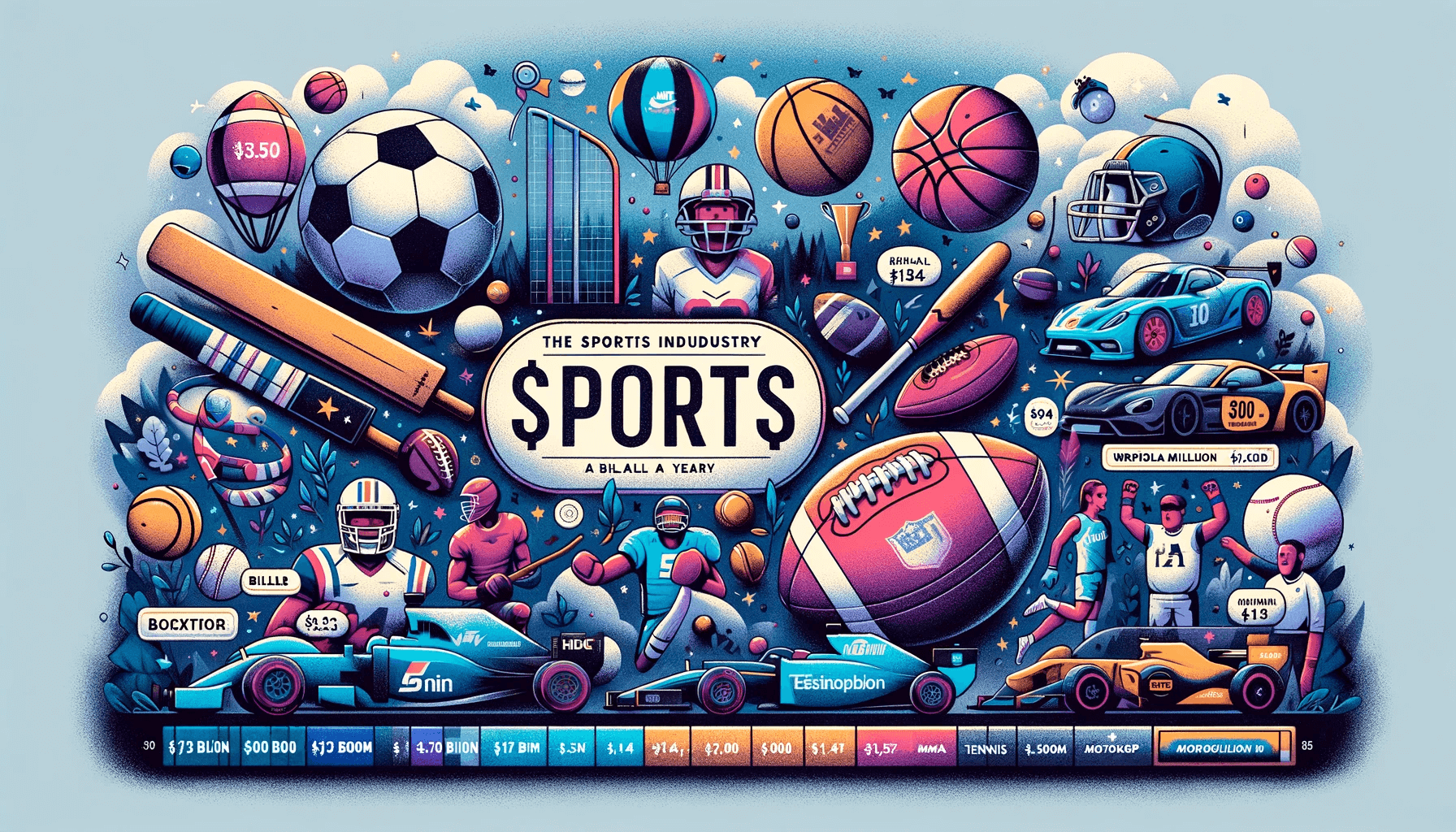Over the past decade, the sports industry has seen significant changes due to technological advancements, evolving fan expectations, and cultural shifts. As traditional sports adjust and new formats emerge, the industry is expanding in unexpected ways. This article covers key growth trends, from the rise of Esports to sustainability efforts.
The Growth of Esports
Expansion of Competitive Gaming Esports has rapidly grown from a niche community to a global phenomenon. What began as a casual hobby is now a billion-dollar industry, with professional leagues, teams, and sponsorships that rival traditional sports. Popular games like League of Legends, Fortnite, and Dota 2 draw massive audiences and feature substantial prize pools.
Esports Viewership and Sponsorship Growth Esports’ popularity stems in part from its accessibility, as fans can watch competitions from anywhere in the world. This global reach has driven massive viewership and attracted major sponsors. Brands like Coca-Cola, Red Bull, and Intel are investing heavily in Esports to engage with its young, tech-savvy audience.
Streaming Platforms Driving Esports’ Rise Platforms such as Twitch and YouTube Gaming have been crucial to the growth of Esports, enabling players to stream live gameplay and interact directly with their fans. This has created a dynamic, fan-driven industry and provided amateur gamers with a pathway to the professional scene.
The Expansion of Women’s Sports
Increased Coverage for Women’s Sports Women’s sports are receiving more media coverage, with networks highlighting leagues in soccer, basketball, tennis, and cricket. Events like the FIFA Women’s World Cup and the WNBA Finals are gaining global attention, increasing visibility and fan engagement.
Growing Sponsorship Deals for Female Athletes Brands are increasingly recognizing the value of sponsoring successful female athletes, such as Serena Williams and Megan Rapinoe, who are becoming global icons. This reflects the growing influence of women in sports and the broader push for gender equality.
Gender Equality Efforts in Sports Leagues Leagues are actively working to reduce gender disparities, particularly in pay and opportunities. Equal pay campaigns and investment in women’s sports development programs are key parts of this movement, creating more opportunities for female athletes and leaders in the industry.
Technological Integration in Sports
Wearable Technology for Performance Enhancement Wearable technology is revolutionizing athlete training and performance. Devices like GPS trackers, biometric sensors, and heart rate monitors provide real-time data to optimize training and prevent injuries by tracking physical stress.
Data Analytics and AI in Coaching Data analytics and artificial intelligence (AI) are being utilized by sports teams to gain a competitive edge. These tools analyze vast amounts of player data to identify patterns and help coaches develop strategies that enhance performance.
VR and AR in Enhancing Fan Experiences Virtual reality (VR) and augmented reality (AR) are changing the way fans experience sports. VR allows fans to enjoy immersive, 360-degree views of games from home, while AR adds real-time stats and information during live events, making sports more engaging and accessible.
Health and Wellness Trends in Sports
Growth of Fitness and Wellness Apps The sports industry is tapping into the health and wellness trend through fitness apps like Peloton and Nike Training Club. These apps offer personalized workout plans and virtual coaching, creating new revenue streams and promoting healthy lifestyles among athletes and fans.
Athlete Mental Health Awareness Mental health has become a key focus in sports, with high-profile athletes like Simone Biles and Naomi Osaka leading the conversation. Leagues are now prioritizing mental health initiatives, offering counseling services and encouraging a healthier work-life balance for athletes.
Corporate Wellness Programs and Sports Partnerships Companies are partnering with sports organizations to promote wellness, with initiatives focusing on both physical and mental health. These collaborations strengthen corporate relationships with the sports industry while improving employee well-being.
The Rise of Sports Betting
Legalization of Sports Betting Sports betting has surged thanks to legalization in markets such as the U.S., creating new revenue opportunities for leagues, betting companies, and media outlets. Fans are more engaged when they can bet on outcomes, which has increased viewership and participation.
Growth of Online Betting Platforms The rise of online betting platforms has made placing bets easier and more accessible. Mobile apps offer live odds and in-game betting options, fueling the growth of sports betting across different demographics.
Leagues Partnering with Betting Companies To capitalize on the sports betting boom, leagues are forming partnerships with betting companies. These collaborations offer new revenue streams and enhance fan engagement by integrating betting features into broadcasts and social media platforms.
Sustainability Initiatives in Sports
Eco-friendly Stadiums and Facilities Sustainability has become a priority in the sports industry, with teams and venues adopting eco-friendly practices. Solar-powered stadiums and water conservation systems are examples of efforts to reduce environmental impact and align with the values of eco-conscious fans.
Zero-Waste Events Leagues are striving to host zero-waste events, where concessions, merchandise, and materials are designed to minimize waste. Recycling, composting, and the use of biodegradable materials are just a few ways sports organizations are promoting sustainability.
Sustainability in Sponsorships Corporate sponsors increasingly prioritize partnerships with sports organizations that share their commitment to social and environmental responsibility. This has led to more meaningful collaborations that promote sustainability and positive social change.
Globalization of Sports
International Leagues and Tournaments The globalization of sports continues to accelerate, with international tournaments like the FIFA World Cup and the Olympics attracting global audiences. Teams and leagues are expanding beyond borders, fostering a connected global sports community.
Sports as a Diplomatic Tool Sports are being used more frequently as a tool for diplomacy and cultural exchange. Major events serve as opportunities for nations to collaborate and build bridges through friendly competition.
Cross-border Fan Engagement and Merchandising The internet and social media have allowed fans from across the globe to engage with their favorite teams and athletes. This has opened up new opportunities for merchandising and fan engagement, as teams cater to a worldwide audience through online campaigns and international fan events.
Athlete Empowerment and Activism
Athletes Advocating for Social Justice Athletes are increasingly using their platforms to speak out on social justice issues like racial equality and climate change. This trend reflects a shift in how athletes view their roles, positioning themselves as advocates for societal change.
Athlete-Driven Media Channels Social media has empowered athletes to take control of their narratives, allowing them to directly connect with fans and build personal brands. This is reshaping the media landscape, as athletes now act as their own media channels.
Rise of Individual Branding Athletes are increasingly focused on building their personal brands, complete with logos, merchandise, and social media empires. This trend is transforming the business side of sports, giving athletes greater control over their careers and financial futures.
Conclusion The sports industry is evolving rapidly, driven by technology, changing cultural values, and global connectivity. From the growth of Esports to athlete empowerment, these trends are reshaping the future of sports. To stay competitive, athletes, teams, and businesses must keep pace with these key developments.





Leave a Comment